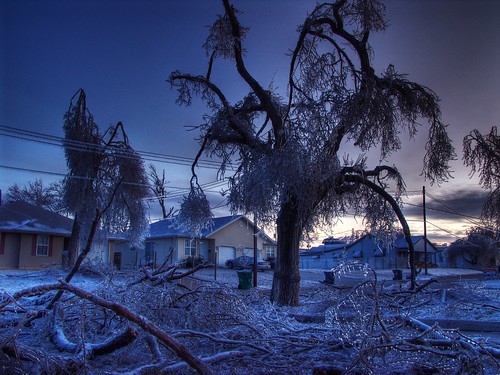Wow, what a great photo of ice storm damage! We're lucky enough not to have many of them here in Norway, but the east coast Americans all know what this is about.
The Ice storm of 1998 (also known as Ice Storm '98) was a massive ice storm that struck a relatively narrow swath of land from Eastern Ontario to southern Quebec to Nova Scotia in Canada, and bordering areas from Northern New York to Southeast Maine in the United States, in January 1998. It caused massive damage to trees and electrical infrastructure all over the area, leading to widespread long term power outages. Millions were left in the dark for periods varying from days to weeks, leading to more than 30 fatalities, a shut down of activities in large cities like Montreal and Ottawa and an unprecedented reconstruction effort of the power grid. (Wikipedia)
What happens is that supercooled rain hits a cold surface and freezes on contact. Supercooled means that the water temperature is below the freezing point, but the droplets still retain their liquid form.
A liquid below its freezing point will crystallize in the presence of a seed crystal or nucleus around which a crystal structure can form. However, lacking any such nucleus, the liquid phase can be maintained all the way down to the temperature at which crystal homogeneous nucleation occurs. The homogeneous nucleation can occur above the glass transition where the system is an amorphous—that is, non-crystalline—solid. Water has a freezing point of 273.15 K (0 °C or 32 °F) but can be supercooled at standard pressure down to its crystal homogeneous nucleation at almost 231 K (−42.15 °C). (Wikipedia)
At midlatitudes, supercooled rain often forms first as an ice crystal or snow in the clouds, which then melts as it falls through an elevated layer of air warmer than freezing before reaching the thick bottom layer of cold air that cools the drop below freezing. A supercooled drop freezes instantly on contact with surfaces such as electrical power lines, trees, and roads during an ice storm. (American Meteorological Society glossary)
Wednesday, 6 June 2007
Icey Morning
Subscribe to:
Post Comments (Atom)

No comments:
Post a Comment